Soft breezes, gentle surf, leaping fish, soaring birds, and sparkling starlit nights await those who embrace island camping in Florida waters.
Pack up your kayaks, canoes and small boats. You can’t drive to these campsites because there are no roads. Just water.
Over the years, we have packed off to many Florida islands in kayaks for long weekends, returning home with a greater appreciation of the outdoors and an abiding sense of adventure.
In this article, we introduce you to dozens of wild islands in the Indian River Lagoon, the Gulf of Mexico, Biscayne Bay and Mosquito Lagoon, some of the best camping you may ever experience in the Sunshine State.
Weather is a critical element of any island expedition, especially when you’re crossing open water. Know your forecast and your tides and plan accordingly.
Indian River Lagoon
Dozens of spoil islands easily accessible by boat, kayak, canoe

There are dozens of spoil islands in the Indian River Lagoon that are open to camping, extending south from Cocoa south to Fort Pierce. No reservations needed. Just go!
Most of the islands in the lagoon are not natural. They are spoil islands built up from sand dredged to deepen channels in the Intracoastal Waterway. As a result, most are close to Intracoastal and other navigation channels.
Many of these islands have designated camping areas with picnic tables and fire rings, but that’s about it. Campfires are allowed but must be contained to fire rings. Fires are prohibited during local or state-wide fire bans.
There are no restroom facilities on any of the islands. Visitors must pack out not just their trash, but all human and pet waste as well. (An inexpensive portable toilet is not a bad idea.)
On weekends, you’ll often find boaters using the islands for picnics and sandbar parties, so arrive early to stake out your own island.
The islands are managed by the state Florida Department of Environmental Protection, the same folks who manage our state parks, under the umbrella of the Spoil Islands Project.
Brevard County Spoil Islands Map
Camping allowed only on Recreational Islands (Green)
BrevardCountySpoilIslandsIndian River County Spoil Islands Map
Camping allowed only on Recreational Islands (Green)
IndianRiverCountySpoilIslandsSt. Lucie County Spoil Islands Map
Camping allowed only on Recreational Islands (Green)
SaintLucieSpoilIslandsCost: No fee to camp, but there may be fees for boat ramp and overnight parking.
Getting there: There are numerous public and private boat ramps with access to the islands all along the lagoon. Near Sebastian Inlet, you’ll find ramps at Sebastian Inlet State Park, Long Point Park, Donald McDonald Park and Sebastian Main Street Public Boat Ramp. Here’s a link to the state boat ramp map to find a ramp near your destination. Call ahead if you are unsure whether you can leave your vehicle overnight.
Ten Thousand Islands
Beach camping by boat
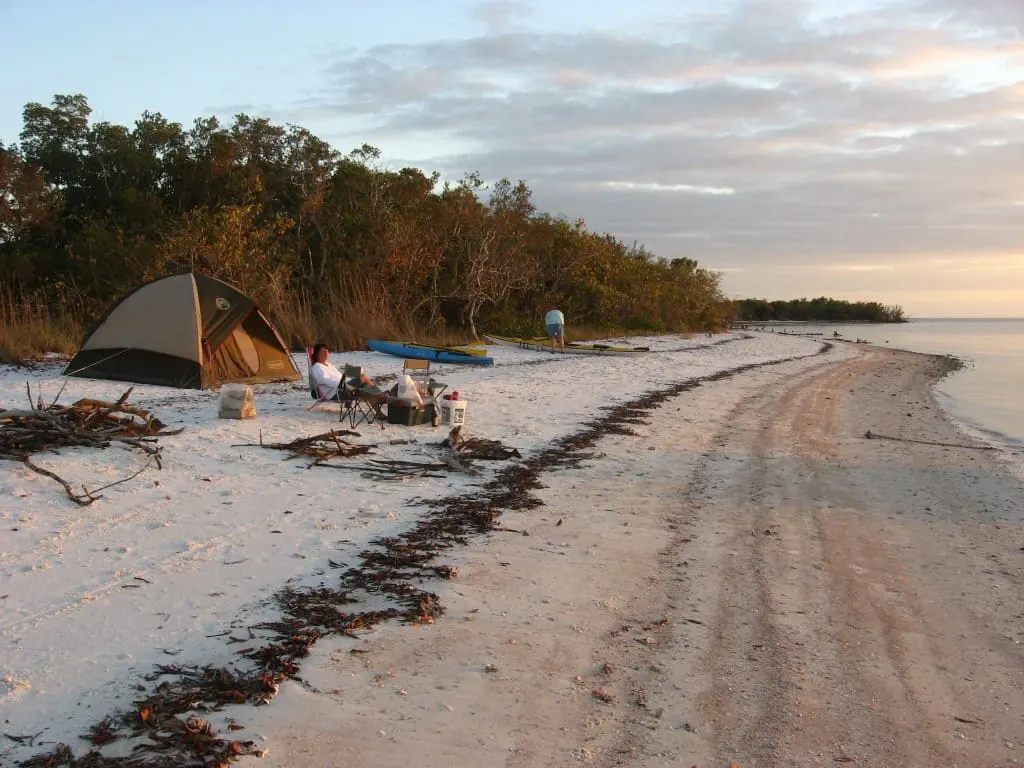
Two of our favorite destinations in the Ten Thousand Islands are Panther Key and Tiger Key, but you’ll find many worthy camping destinations among these islands off the coast of Southwest Florida.
The 100-mile Wilderness Waterway in Everglades National Park is popular with adventurers who paddle from Everglades City to Cape Sable, overnighting on islands and tiki platforms along the way.
Overnight beach camping on Panther Key is OK from October through April, and no permit is required. In summer, camping is banned to allow nesting by sea turtles and shorebirds.
While Panther Key is in the Ten Thousand Islands National Wildlife Refuge, Tiger Key two miles its south is in Everglades National Park and requires a permit obtainable as the park’s Gulf Coast Visitor Center in Everglades City.
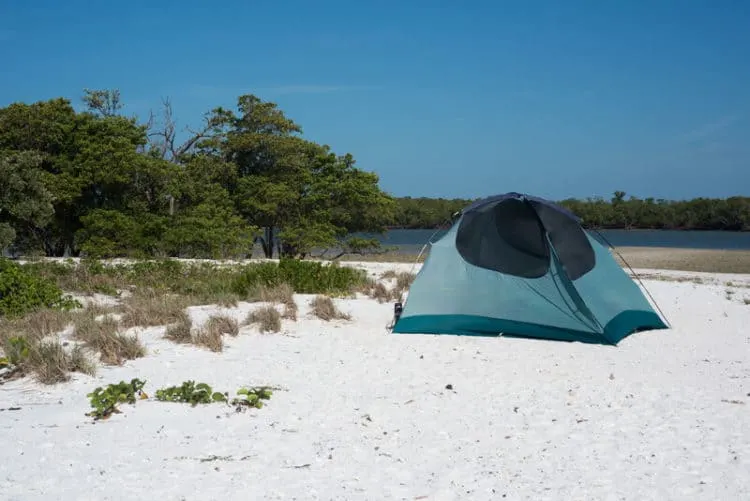
Each island has its own charm. The beach campsites on Tiger are on the leeward side of the island on a quiet lagoon, protected from wind and weather, while Panther’s beaches are more expansive and can accommodate large numbers of campers.
There are no facilities on either island. There is a vault toilet on Picnic Key, adjacent to Tiger Key. Picnic Key is another camping option if Tiger is occupied, but it’s not as nice and the unsheltered sites face the open gulf.
Cost: Camping is free on Panther Key, but you need a $15 permit to camp on Tiger Key from mid-November through mid-April. Additionally, a camping fee of $2 per person per night.
Getting there: Launch kayaks from the Gulf Coast Visitor Center in Everglades City, where you also obtain permits for Tiger Key. Paddle across shallow Chokoluskee Bay at high tide, then out through Indian Key Pass on the outgoing tide to the open water of the gulf. Go north about two miles to West Pass and land on the back side of Tiger Key. It’s a 9-mile paddle. Go past Tiger another two miles to Panther Key. Time your return for the incoming tide.
Anclote Key Preserve State Park
Tent camping via kayak or motorboat
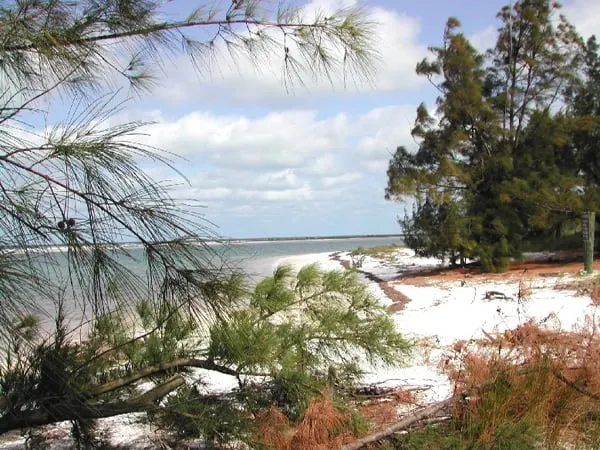
Anclote Key is an island paradise three miles off the coast of Tarpon Springs with beautiful beaches and a picturesque 1887 lighthouse that stands on the southern end of the island.
Campers are welcome to pitch a tent on the north end of the island for an idyllic beach-camping experience under the stars.
The island has two compostable toilets on the island, one for day visitors and the other in the camping area. There is no water or any other amenities, so you will have to bring everything you need and leave nothing behind.
Cost: There are no fees for camping on Anclote Key. Sites are available first come, first served.
Getting There: For campers, you must have your own boat or kayak. Ferry service is only available for day visitors, not overnight campers. Launch your kayak at Anclote Gulf Park in Tarpon Springs for the 3 1/2 mile paddle across open water. You should have at least one experienced kayaker in your group. Knowing the weather forecast is critical.
Read more: Anclote Key Preserve State Park
Mosquito Lagoon
Backcountry camping, Canaveral National Seashore
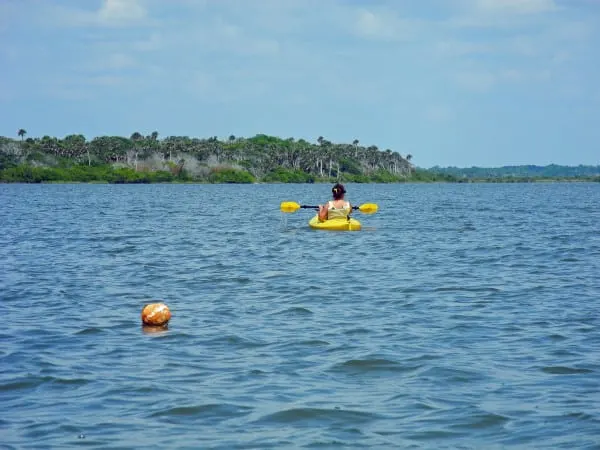
There are 14 island campsites available for reservation in the Mosquito Lagoon backcountry of Canaveral National Seashore, including both natural island and spoil island campsites accessible only by boat, kayak or canoe.
You can reserve individual sites up to 6 months in advance through Recreation.gov for $20 per night. Sites are available year round.
I’ve explored these islands in Mosquito Lagoon, fishing for redfish around the ubiquitous oyster bars, but I never actually camped here.
I have lived near the lagoon, though, and can affirm it is not misnamed. There certainly are mosquitoes, especially in summer, and the no-see-ums are unrelenting at dusk.
There is a picnic table and fire pit on each campsite, so bring your own firewood. Trash is pack it in and pack it out. You may bring your own camping stove.
Some of the sites are quite nice, others not so much, but you will certainly enjoy being immersed in the abundant wildlife.
Cost: Sites are $20 per night, and some can accommodate up to 60 people. Reservations accepted up to 6 months in advance at Recreation.gov. There is a map of sites, and you will be asked to enter the number of campers before available sites are displayed for your requested dates.
Getting there: Follow State Road A1A from New Smyrna Beach six miles south to the entrance of Canaveral National Seashore, where there is a boat ramp to access Sites 1-5, including Shipyard Island. Access Sites 6-14 are accessible from the boat ramp at Riverbreeze Park, 250 H.H. Burch Road, Oak Hill, just off U.S. 1 on the west side of the lagoon.
Read more: Canaveral National Seashore: Florida’s longest unspoiled beach
Biscayne National Park
Tent camping via motorboat, sail or kayak
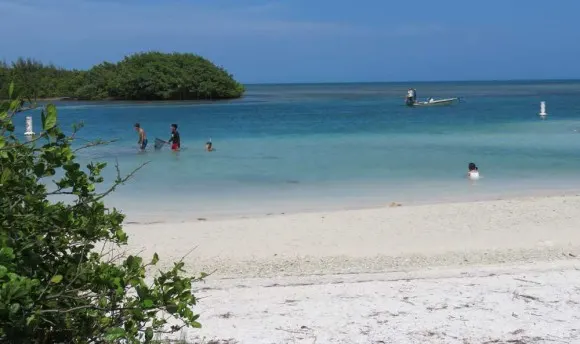
Two islands in Biscayne National Park accommodate campers on primitive sites with limited amenities, and both islands are accessible for camping only by private boats.
Boca Chita Key is the park’s most popular island. It features beautiful waterfront views, a grassy camping area, picnic tables and grills. Toilets are available, but there are no showers, sinks or drinking water. A cleated bulkhead is the only place for docking.

Elliott Key is the park’s largest island. Restrooms with sinks and cold water showers, picnic tables and grills are available. Drinking water is available, but bring your own water as a precaution if the system goes down. There are 33 boat slips in the marina.
The 7-mile paddle by kayak across Biscayne Bay is difficult, but not impossible for experienced paddlers. Leaving a vehicle in the parking lot at the park’s Visitor Center is permitted when camping on one of the park islands, but you’ll need to fill out a free parking permit.
Cost: $25 per night including tent site and boat docking ($12.50 per night with senior pass.) Tent camping only is $15 per night. Sites are first come, first served. Payments with exact change upon arrival. Camping and docking fees are waived from May 1 to September 30. There is no ferry service for campers.
Getting there: Take Exit 6 (Speedway Boulevard) from Florida’s Turnpike. Turn left and go south to SW 328th Street. Turn left on 328th Street and continue four miles to the end of the road. The park entrance is on the left at 9700 SW 328th Street, Sir Lancelot Jones Way, Homestead. Motorboats and sailboats access the islands from Miami, but use navigation charts. While there are channel markers, first-timers will undoubtedly encounter shoals.
Read more: 7 reason to explore Biscayne National Park
Dry Tortugas National Park
Tent camping by ferry or seaplane out of Key West
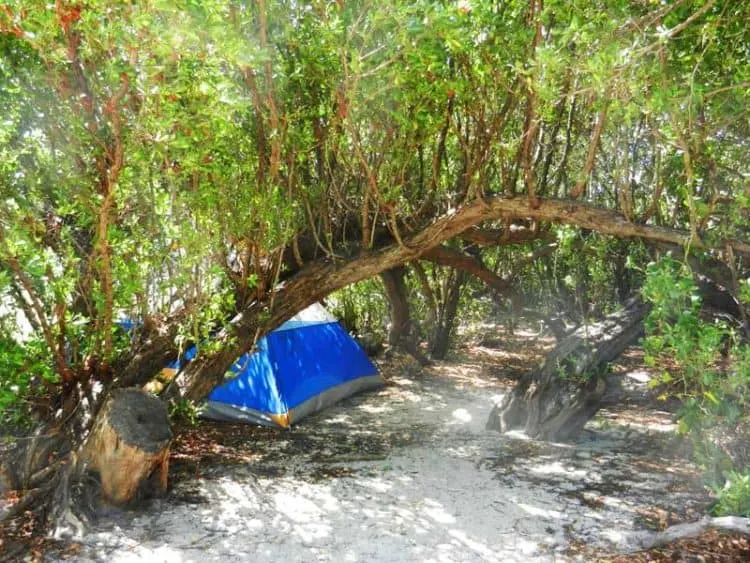
The Tortugas are waaaaaaaay out there. About 60 miles west of Key West, a two-and-a-half hour ferry ride.
Experienced boaters are frequent visitors, drawn by the outstanding fishing, but for most people, the Yankee Freedom ferry out of Key West is the only option.
The campground is on Garden Key, adjacent to Fort Jefferson, a historic fort built during the Civil War by Union Troops to intercept supplies going to the Confederacy. After the war, it became a prison that housed Dr. Samuel Mudd, the physician who set the broken leg of John Wilkes Booth.
Not much compares with wandering Fort Jefferson in late afternoon after the ferry leaves, when you can be absolutely alone with the history and the ghosts.
Or looking up at night at the black night sky to see the Milky Way – stars I last saw as a child. Or seeing the sunset from a beach where there is no chance of a crowd or manmade noise. Or watching 20 magnificent frigate birds soar overhead with their 7-foot wingspans.
Camping here is a test of packing skills. You must bring everything, and you must keep your gear condensed in tote bags or bins. You must be able to load it on and off of the ferry by yourself.
Cost: Aye, matey, there’s the rub. The camping fee is only $3 per person per night, payable in cash when you arrive, but it will cost $175 to $195 round trip for the ferry ride. Reservations are limited because there are only 11 campsites on the island.
Getting there: The Yankee Freedom ferry leaves from the Key West Seaport, behind the Half-Shell Raw Bar. Campers must be ready to board at 6:30 a.m. The ferry leaves at 8 a.m. and arrives on the island around 10:30 a.m. For your return, you board the ferry by 2:30 p.m. Carts are available at Fort Jefferson’s dock for transporting your gear to the campground.
Read More: Camping at Dry Tortugas National Park
Cayo Costa State Park
Tents, cabins and a ferry to get you there
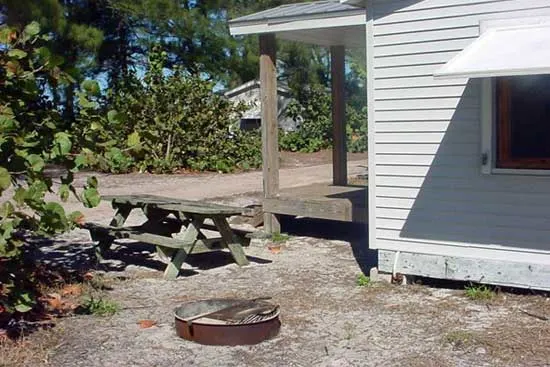
An hour by ferry from Pine Island, Cayo Costa is not cheap or quick to reach. That’s part of its charm. Half of the island is a state park, so it remains unspoiled and wild. There are homes on the south end but no paved roads. The only vehicles you’ll see are bicycles and park trams that bring you to the campground from the docks.
Cayo Costa has 30 primitive tent sites with a picnic table, a ground grill and access to potable water. No sites have electricity. A handful of sites are available for hammock camping.
There are 12 rustic one-room cabins near the beach. Each sleeps up to six people, furnished with three bunk beds and a table. The cabins have no electricity or water, but potable water is available at restrooms. Outdoor grills are provided for cooking.
There are 20 slips for boat camping at the park’s dock on Pine Island Sound.
Cost: Tent sites are $22 per night, and cabins are $40 per night, plus a non-refundable $6.70 booking fee. Overnight boat slips are $20 per night. For reservations, call 800-326-3521 or book online.
Getting there: The park is accessible only by private boat or passenger ferry service. Call Captiva Cruises at 239-472-5100 for ferry reservations. The ferry connects to Cayo Costa from Captiva Island, Punta Gorda and Pine Island.
Read more: Live your dreams of a private island
Everglades National Park
Remote tent camping by kayak
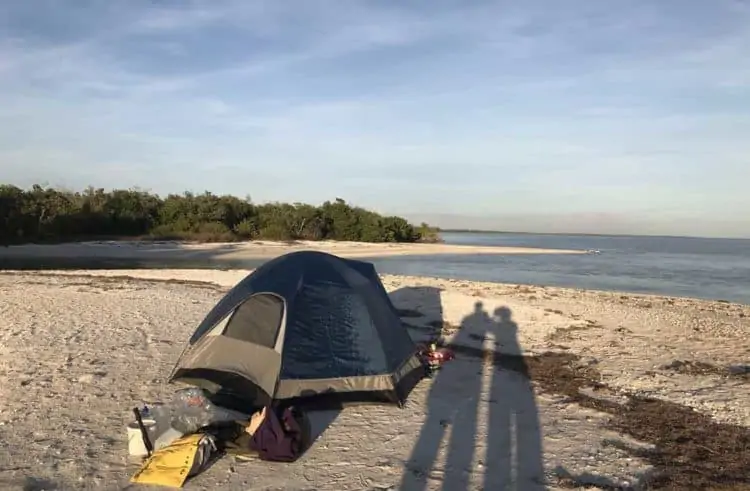
At the very bottom of the Florida peninsula, the sole road through Everglades National Park leads to Flamingo on Florida Bay. From the Flamingo marina, if you paddle west along the coast, you leave civilization behind. It’s a world where you see birds and a variety of wildlife, from crocodiles to sharks.
There are several designated wilderness camping areas along this Cape Sable peninsula. The closest is Clubhouse Beach, about a three hour paddle. If you keep kayaking (11 miles from Flamingo), you reach the extensive beaches of the Cape Sable peninsula where Florida Bay waters meet the Gulf of Mexico. For us, it was a six hour paddle out and almost 11 hours against the wind and tide for our return.
We loved our campsite here, where we had memorable views of both the sunset and sunrise. You are allowed to gather driftwood and build a campfire, and our site had the view of a sandbar where dozens of sea birds came and went offering endless entertainment.
Cost: All back country camping in Everglades National Park requires a permit. For two people it is $21 plus $2 per person. Permits are easy to get now that you do it through recreation.gov. You can book a permit up to 90 days in advance. You must check in at the appropriate ranger station (Flamingo if you’re going to Cape Sable) the morning before you leave.
Getting there: Launch kayaks from the Flamingo marina, at the end of the road that starts at the Homestead entrance to Everglades National Park.
Read more: Fabulous Florida wilderness camping: Paddling Flamingo to Cape Sable
Recap Map
[mappress mapid=”554″ alignment=”left” initialopeninfo=”false”]

Veteran journalists who worked together at Fort Lauderdale’s SunSentinel newspaper, Bonnie and Bob founded FloridaRambler.com in 2010 to explore the natural, authentic Florida, writing about their natural interests in hiking, biking, paddling, RV and tent camping, wildlife, unique lodging, dining and historic places.

Lynn Magoulis
Monday 26th of October 2020
We raised our boys camping in tents, a pop-up camper, a slide-on truck camper & eventually a small 5th wheel, but their favorite times camping were probably during the adventures they had primitive camping on the out islands off the coast of Florida, a little south of Anclote Key closer to Palm Harbor, north of Honeymoon Island State Park. We used a small Jon boat to haul our tent, supplies, fishing poles & cast nets until we could afford a larger boat. So many great experiences & memories were made-it was like camping in paradise!
Rick Cunningham
Monday 26th of October 2020
Thanks Bob - great info as always. 1- I have been to the Ft Pierce Spoil islands a few times. There WILL be partiers on the weekends. 2- 3 of us did a night each at Rabbit & Panther Keys. We had 1 kayak and 1 canoe which was great for hauling gear (cold beer!). Would love to go back to Panther in a boat pulling kayaks. That way you could bring more stuff and also cruise around during the day. Really need to time the tides on this trip. We made it back from Panther in less than 2 hours on incoming tide and saw at least 3 outbound kayaks that were swamped with water as they were trying to fight it going west. Could have maybe taken them 5 hours for same trip. 4- Thanks so much for the info on booking sites in Canaveral NS. Previously they made you drive all the way to the Ranger Station to register which was probably 1.5 hours or more r/t from Riverbreeze Park. Definitely will do this now.
Bob Rountree
Monday 26th of October 2020
Having a motorboat out at Panther Key with your party is a good idea for many reasons, and timing your trips with the tides is absolutely essential. I've been out there twice in my center console (hauling kayaks and beer!) and highly recommend it.